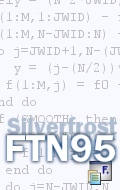ClearWin+ is a library built into the FTN95 run-time system. It offers an easy to use interface to the Windows API and is not available when producing .NET code. It makes use of a set of format codes and call-backs. The format codes resemble C style printf codes. ClearWin+ is used to power the UI for Simfit. From FTN95 version 7.00 a 64-bit version of ClearWin+ is included. This can be used with existing, free, 64-bit compilers.
INTEGER i,winio@EXTERNAL funci=winio@('Press this to see what happens &')i=winio@('%^bt[PRESS]',func)ENDc---Function todo something---INTEGER function func()func=1ENDA full GUI interface with windows, menus, popup dialog boxes, list boxes, edit boxes, bitmaps, toolbars, etc can be developed using the available format codes. Applications written using ClearWin+ can also contain graphics regions, enabling charts and graphs to be included. OpenGL graphics can also be included.
A simple ClearWin+ program that demonstrates two dimensional graph plotting using ClearWin+:
USE clrwinINTEGER,PARAMETER::n=101REAL*8x(n),y(n),th1,a,dth1! Generate x-y data arraysa=1.d0th1=0.d0dth1=4.d0*ATAN(1.d0)/25.d0DO i=1,n,1x(i)=a*SQRT(th1)*COS(th1)y(i)=a*SQRT(th1)*SIN(th1)th1=th1+dth1END DO! Configure plotCALL WINOP@('%pl[frame,etched,gridlines,colour=blue,width=2,symbol=5]')CALL WINOP@('%pl[smoothing=4,x_array,margin=100]')CALL WINOP@('%pl[Title="Fermat''s spiral"]')! Set window font (%fn), text size (%ts), and set to bold (%bf)i=WINIO@('%fn[Tahoma]%ts%bf&',1.5d0)! Create a 800 x 800 graphics region, and plot curve defined by data in x and yi=WINIO@('%pl',800,800,n,x,y)END
